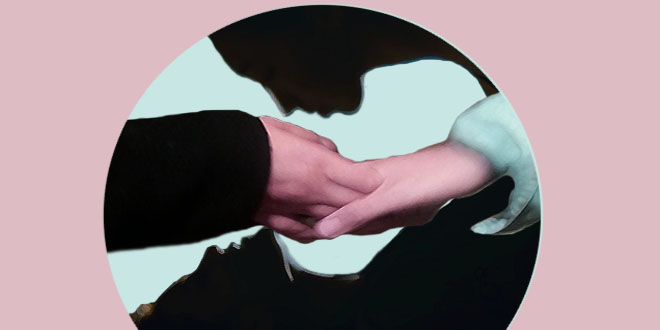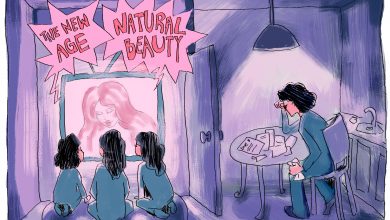4 Ways Men Objectify Lesbians

Design by Katherene Quiteno.
At some point in human history, men decided that women belonged to them. Today, in the United States, women are allowed to have property, money, and lots of other things they couldn’t have in the past, but for some reason we haven’t quite gained control of our bodies.
Heterosexual men control women’s bodies in a variety of ways, including restricting our access to abortion and healthcare, sympathizing with accused rapists, and objectifying and trivializing our sexuality. That last one is especially true for non-heterosexual women, who are consistently a target of objectification and fetishization for heterosexual men.
Here are four assumptions men tend to make about lesbians, or otherwise non-heterosexual women, that contribute to the objectification of women.
1. Women’s sexuality is a choice.
When ads in men’s magazines pose straight women in sexual positions with each other, it sends the message that female sexuality is a choice. Specifically, it’s a choice made for men’s pleasure.
The media-enforced stereotype that women tend to “experiment” with other women in college also enforces the idea that women’s sexuality is a choice. Furthermore, for women who do experiment with their sexuality when they’re young, it’s all too often cut short because of societal pressures to conform to heterosexuality. While there’s nothing wrong with trying new things, the way this “experimenting” stereotype applies only to women implies that men’s sexuality is fixed, and women’s can change.
While sexuality may be complicated and multifaceted, and it can be a choice for some people, it’s not a choice for everyone. Women don’t always just choose to be lesbians, and they especially don’t choose to be lesbians for men’s pleasure.
Assuming that women’s sexuality is a choice, while men’s is fixed, trivializes women’s sexuality. It implies that men’s sexuality is innate, but women “experiment.”
2. It’s only hot when they’re thin and white.
Based on the prevalent depictions of lesbians in media and advertising for men’s enjoyment, it seems men are really, really into lesbians. But the women depicted as lesbians in media and advertising are incredibly homogeneous.
Non-heterosexual women, just like heterosexual women, do not all fit this tall, thin, white mold. Yet that is what the vast majority of lesbians in film, TV, advertising, and other media look like.
For example, take the Netflix series Orange is the New Black. Many consider it a premier example of lesbian representation. Yes, it has some of the most complex lesbian and transgender characters on TV.
But the majority of the sympathetic lesbian characters are conventionally “feminine,” meaning traditionally pretty with thin bodies and long hair, as is the case with the main character Piper and her on-and-off girlfriend Alex. When it comes to characters who are thicker, shorter, more “masculine,” or darker skinned, lesbian sexuality becomes a farce, reduced to urinating on the floor for attention and masterbating with a screwdriver, as we see with characters like Crazy Eyes and Boo.
That show in particular is not specifically directed at men. But it enforces the stereotype that lesbian sexuality is only acceptable when the women involved are conventionally feminine. This stereotype is also enforced by ads that are specifically directed at men.
3. Lesbianism happens in the bedroom
Another common assumption men like to make is that lesbian relationships are purely sexual. While there’s nothing wrong with relationships that are purely sexual, assuming that all are objectifies lesbians by portraying their relationships as lacking the personal connection of heterosexual relationships.
This article, though somewhat problematic, hits upon an important point: “[Lesbians] aren’t just pretty nubile ‘girls’ doing that ridiculous tongue thing that no real lesbian has ever done in her life. We have lives beyond what we do in bed.”
4. Female relationships are for male consumption
Hollywood likes to portray female relationships, sexual or not, as if they are for a man’s benefit. Whether it’s for a male character within the film or show, or for a male-by-default audience, female relationships are meant to be watched.
This is especially apparent in advertising. While many ads feature female models in positions of intimacy, their focus is almost always toward a male viewer.
It also shows up in virtually any television show you can think of. On TV this trope is usually played for laughs, portraying the man as sleazy but hilarious. It usually takes the form of a man overhearing a conversation between two women and interpreting it as sexual tension, then asking them if he can watch.
However, portrayals of this blatant invasion of privacy hardly ever come close to touching upon how creepy it is for a man to ask two women if he can watch them have sex for his own pleasure.
This may come as a surprise to some men who grew up being told the world belonged to them, but women are allowed to form relationships with each other without men being involved. Women of any shape, size, color, or sexual orientation can form relationships with each other without men watching, participating, or even knowing about it.
When men make these assumptions about lesbians, they objectify and trivialize the sexuality of women of all sexual orientations.
There isn’t nearly as much LGBTQIA+ representation in media as there needs to be, and the representation that exists, particularly of non-heterosexual women, is made for the male gaze. Positive and inclusive representation in media is a huge part of communities losing the harmful stereotypes that help to oppress them.
Once we as a society realize that women’s bodies and relationships do not and should not belong to men, we can move forward and create some positive and representative portrayals of non-heterosexual women. Hopefully then, women will get a bit closer to taking our bodies back.




